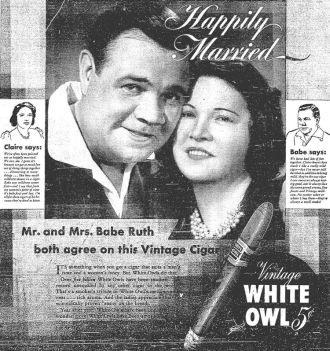
This advertisement of Babe Ruth and his wife Claire, singing the praises of White Owl Cigars, appeared in the ‘L.A.Times” newspaper, Dec 1938, and likely other publications as well.
Babe Ruth by this time was retired from active play, having made his last professional appearance with the Boston Braves in May 1935. His celebrity, however, was still very much intact, and remained so for a number of years beyond his playing days. His image and endorsement were sought by numerous interests, many wanting him to pitch their products directly.
In this ad, the central message from White Owl cigars is printed in bold just beneath the photo of the happy couple: “Mr and Mrs. Babe Ruth both agree on this Vintage Cigar.” The ad also uses the “Happily Married” tagline above the main photo, inferring that White Owl Cigars somehow contribute to marital bliss.

Claire Ruth.
“…We’ve often been painted out as happily married. We are, too. I guess it’s because we get so much fun out of doing things together…discovering so many things… like how much mildness means in a cigar. Babe says mildness comes first — and I say that from my woman’s point of view it’s both first and last. I’m all for those cigars of his because they’re kind to kisses.”
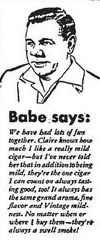
Babe Ruth.
“…We’ve had lots of fun together. Claire knows how much I like a really mild cigar — but I’ve never told her that in addition to being mild, they’re the one cigar I can count on always tasting good too! It always has the same grand aroma, fine flavor, and Vintage mildness. No matter when or where I buy them, they’re always a swell smoke!”
The text from White Owl at the bottom of the ad then continues:
“It’s something when you get a cigar that suits a man’s taste and a woman’s fancy. But White Owls do that. Over five billion White Owls have been smoked… a record unequaled by any other cigar in the world. That’s a smoker’s tribute to White Owl’s mellow mildness…rich aroma. And the ladies appreciate its scientifically proven ‘easier on the breath.’
“Year after year, White Owls have been improved… No wonder more White Owls have been smoked more than any other cigar…”
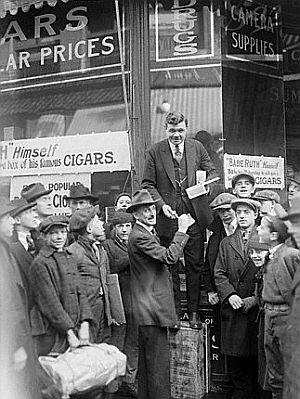
Babe Ruth selling his cigars in front of a Boston drug store & tobacco shop, February 1920.
Ruth reportedly preferred the larger cigars. “Twice he went to Cuba to bring back Havanas,” according to Baseball Hall of Fame researcher Bill Jenkinson.
There are some accounts of Ruth on his fairly active road nights, going through four of five cigars an evening. One teammate, pitcher Waite Hoyt remembers Ruth on the road relaxing in his hotel suite, and lighting up “a long 60-cent cigar.”
There are any number of photos of Ruth showing him smoking at leisure, smoking in his car, even smoking while hitting a ball. There is also a 1919 vintage photo of him sitting at a work bench rolling cigars.
In fact, during his early playing years in Boston, Ruth had invested some of his money in a small local cigar business that manufactured a “Babe Ruth” nickel cigar complete with his picture on every wrapper.
“I smoked them until I was blue in the face,” Ruth reportedly said of those cigars. But Ruth also spent some time promoting his cigar venture, as the 1920 photo at left shows him standing on a makshift platform pitching cigars in front of a Boston cigar store. Another photo below shows Ruth at the counter inside the store making a sale.
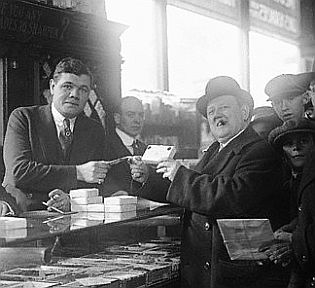
Babe Ruth shown making a cigar sale at Boston tobacco shop, February 1920.
Beyond his cigar business venture, however, and as a result of his baseball fame, Babe Ruth was a sought-after celebrity. He was regularly sought out to sell all manner of commercial products — both during his playing career and for some years after, as in the White Owl cigar ad above.
Ruth also lent his name and/or image to a wide array of advertisers, and he endorsed a number of products in one way or another.
Among some of the Babe Ruth-endorsed products were: Wheaties breakfast cereal, Quaker puffed wheat cereal, baseball gloves, Spalding baseballs, Sinclair gasoline, Esso gasoline, Tydol Ethyl gasoline, Mrs. Sherlock’s Bread, Babe Ruth All-American Underwear, Ruth’s Home Run Candy, girl scout cookies, Red Rock Cola, Babe Ruth Gum, Louisville Slugger baseball bats, and other products.
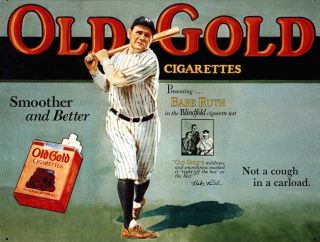
Babe Ruth featured in advertisement for Old Gold cigarettes, probably from the 1920s.
In his prime-time playing years, Ruth also did advertising spots for chewing tobacco, as seen in the ad below for Pinch-Hit Chewing Tobacco. In 1927, he appeared in the Hollywood film, “Babe Comes Home,” with actress Anna Nilsson, a film in which chewing tobacco is part of the storyline. Ruth also lent his name and image to advertising spots for Kaywoodie pipe tobacco.
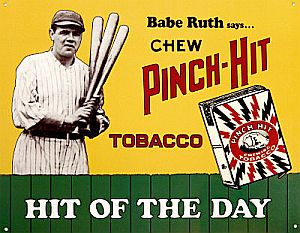
Babe Ruth image and endorsement for Pinch-Hit chewing tobacco, undated.
In 1946, just before retiring from baseball, Ruth was diagnosed with nasopharyngeal carcinoma, a rare form of cancer which tends to infiltrate other organs.
The location of Ruth’s cancer was in the nasopharynx, or the upper part of the throat behind the nose.
Doctors did their best to arrest Ruth’s cancer, using surgery and radiation treatments, but they were not successful, and eventually released him from the hospital in 1947.
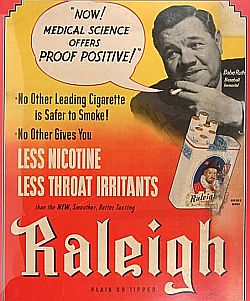
Babe Ruth in 1945 ad for Raleigh cigarettes.
See also at this website: “Babe Ruth Days, 1947-1948;” “Ruth At Oriole Park, 1930s-2009; “The Babe Ruth Story, 1948” (book & film); and “Baseball Stories, 1920s-2000s,” a topics page with additional baseball history. For additional stories on advertising see the “Madison Avenue” category page. Thanks for visiting — and if you like what you find here, please make a donation to help support the research and writing at this website. Thank you. – Jack Doyle
|
Please Support Thank You |
___________________________________
Date Posted: 25 September 2010
Last Update: 20 December 2019
Comments to: jdoyle@pophistorydig.com
Article Citation:
Jack Doyle, “Babe Ruth & Tobacco, 1920s-1940s,”
PopHistoryDig.com, September 25, 2010.
____________________________________
Sources, Links & Additional Information
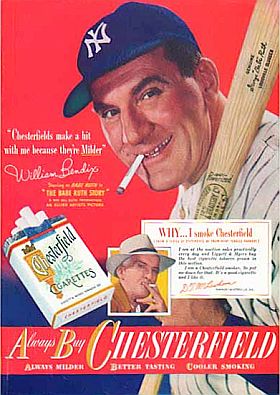
About a month after Ruth’s death in Sept 1948, “The Babe Ruth Story,” a film by Allied Artists starring William Bendix, was released to theaters. Bendix is shown above in a 1948 back-page magazine ad attired in his Babe Ruth outfit, singing the praises of Chesterfield cigarettes. It appears he is also holding a Babe Ruth-monogrammed “Louisville Slugger” baseball bat. Click for film DVD.
Larry Schwartz, “Lovable Ruth Was Everyone’s Babe,” Special to ESPN.com.
Leigh Montville, The Big Bam: The Life & Times of Babe Ruth, New York: Doubleday, 2006.
“Famous People Who Have Died from Cigar-Related Disease,” The Wellness Letter, University of California at Berkeley, January 1997, Volume 13, Issue 4.
“Babe Ruth: Famous People Who Have Suffered from Oral, Head, and Neck Cancer,” American Academy of Otolaryngology — Head and Neck Surgery, 2010.
Jack Doyle, “Babe Ruth Days, 1947 & 1948,” Pop HistoryDig.com, April 17, 2008.
Jack Doyle, “Ruth at Oriole Park, 1930s-2009,” Pop HistoryDig.com, March 29, 2009.
The Babe Ruth Birthplace and Museum, Baltimore, Maryland.
Kenneth Shouler, “The King of Swings: Babe Ruth Revolutionized Baseball While Indulging a Passion for Wine, Women and Cigars,” CigarAfici- onado.com.
____________________________________